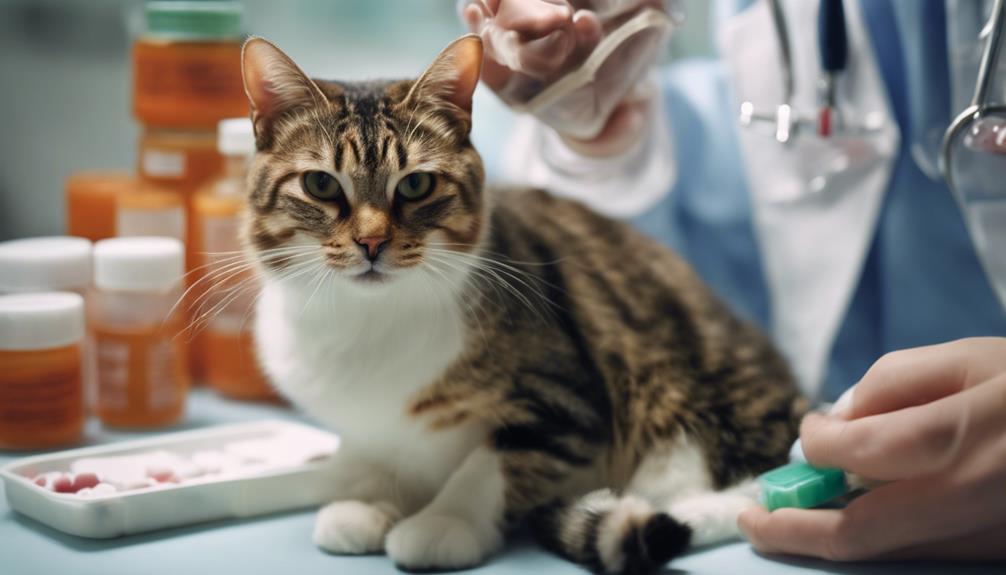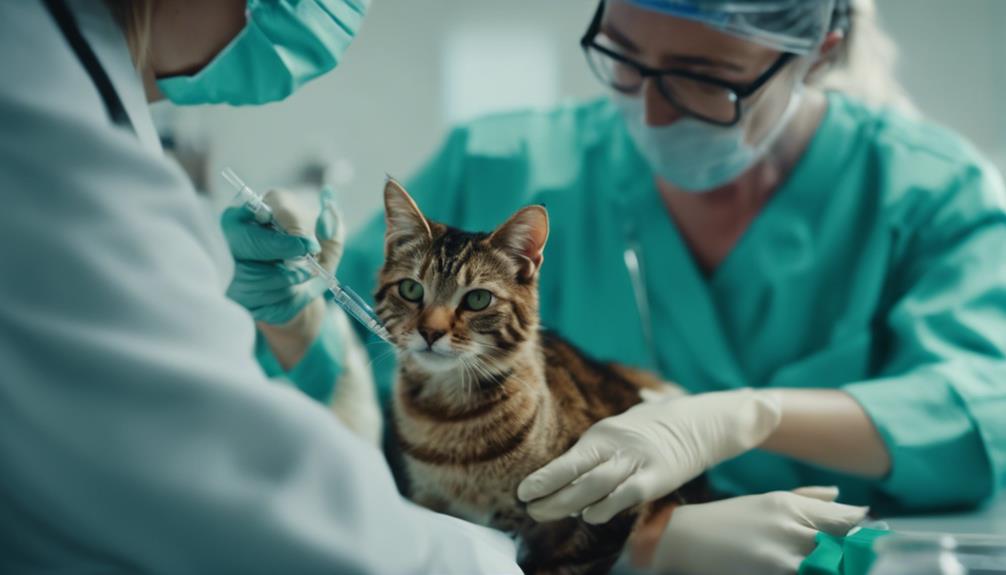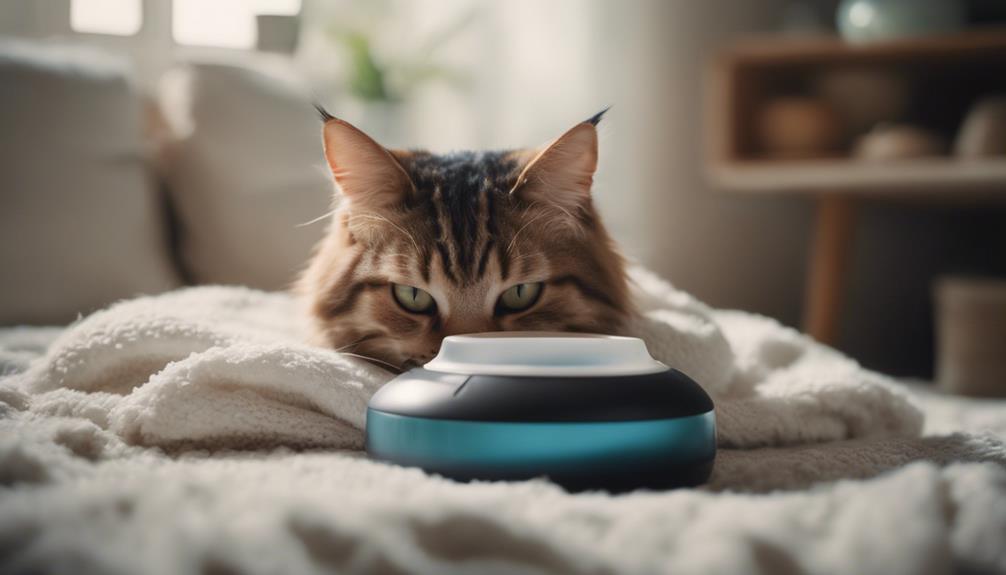Feline Calicivirus, a seemingly innocuous term, carries significant weight in the realm of feline health.
The manifestations of this virus go beyond a mere cold in your beloved cat, posing potential risks that demand attention.
From subtle symptoms to broader implications, understanding the depth of Feline Calicivirus sheds light on the necessity of proactive measures.
As we uncover the layers of this viral concern, a clearer picture emerges, urging us to grasp the gravity of the situation and the measures required to safeguard our feline companions' well-being.
Key Takeaways
- Feline Calicivirus is highly contagious and can lead to severe respiratory issues in cats.
- Regular cleaning and disinfection are crucial in preventing the spread of the virus.
- Vaccination is essential to reduce the severity and duration of Feline Calicivirus.
- Stress weakens the immune system, making cats more susceptible to the virus.
Understanding Feline Calicivirus Transmission
Transmission of Feline Calicivirus occurs primarily through direct contact with secretions from infected cats' eyes or nose, grooming behaviors, and sharing contaminated items. This highly contagious virus can also spread through the air, making it crucial to isolate infected cats.
Signs typically manifest within 2-14 days post-exposure, with infected cats shedding the virus for extended periods. To prevent transmission, regular cleaning and disinfection are essential. Keeping cats indoors, away from crowded environments, and introducing new cats gradually can help reduce the risk of infection.
Stress can weaken the immune system, making cats more susceptible to Feline Calicivirus. By understanding how this virus spreads, cat owners can take proactive measures to protect their feline companions and minimize the spread of the disease.
Symptoms and Manifestation in Cats
Understanding the symptoms and manifestation of Feline Calicivirus in cats is crucial for timely identification and management of this common upper respiratory infection. Cats infected with Feline Calicivirus may exhibit symptoms such as nasal and ocular discharge, sneezing, conjunctivitis, and mouth ulcers. These signs can cause discomfort and affect the overall well-being of the cat, especially if left untreated.
Manifestations of the virus can vary in severity, with some cats experiencing mild symptoms while others may develop more serious complications like pneumonia. Monitoring your cat closely for these symptoms and seeking veterinary care promptly can help in providing appropriate treatment and support to alleviate their discomfort and prevent potential complications associated with Feline Calicivirus.
Importance of Timely Diagnosis

Prompt diagnosis of Feline Calicivirus is crucial for initiating timely treatment and preventing further complications in infected cats. Timely identification of the virus can significantly impact the outcome for your feline companion.
- Quick Response: Enables immediate treatment interventions.
- Prevents Spread: Helps contain the virus and protect other cats.
- Reduces Severity: Early detection can lead to less severe symptoms.
- Improves Prognosis: Increases the chances of a full recovery.
- Enhances Comfort: Allows for prompt relief of discomfort in infected cats.
Treatment Options for Calicivirus
When addressing Feline Calicivirus, treatment options focus on alleviating respiratory and oral symptoms and managing secondary infections to support the affected cat's well-being. The primary goal is to provide comfort and aid recovery. Below is a table outlining common treatment options for Feline Calicivirus:
| Treatment | Description |
|---|---|
| Nebulizer Therapy | Helps alleviate respiratory symptoms |
| Pain Medications | Provides relief from oral discomfort |
| Antibiotics | Treats secondary bacterial infections |
These treatments are essential in managing Feline Calicivirus, aiming to reduce the severity of symptoms and support the cat's overall health during recovery.
Significance of Antibiotics in Treatment

The utilization of antibiotics plays a crucial role in the treatment protocol for Feline Calicivirus, targeting and addressing secondary bacterial infections to support the overall recovery of affected cats. Antibiotics are vital in combating bacterial complications that may arise alongside the viral infection, aiding in the restoration of the cat's health.
In the treatment of Feline Calicivirus, antibiotics serve the following purposes:
- Combat Bacterial Infections: Addressing secondary bacterial infections that can worsen the cat's condition.
- Support Immune System: Assisting the immune system in fighting off additional health threats.
- Prevent Complications: Reducing the risk of further complications that may prolong recovery.
- Enhance Recovery: Promoting a speedier and more complete recovery process.
- Improve Overall Well-being: Contributing to the cat's overall well-being and comfort during treatment.
Nebulizer and Pain Management Strategies
Effective management of Feline Calicivirus involves utilizing nebulizers and implementing pain relief strategies to alleviate respiratory discomfort and oral ulcers in affected cats.
Nebulizers deliver medication directly to the respiratory system, helping to open airways and reduce inflammation. This can significantly improve breathing and overall comfort for cats struggling with respiratory symptoms.
Additionally, pain management strategies such as providing soft food, using topical oral gels, or administering pain medications can help alleviate the discomfort caused by oral ulcers.
Vaccination as a Preventive Measure

To combat the threat of Feline Calicivirus and safeguard feline health, prioritizing vaccination as a preventive measure is paramount. Vaccination plays a crucial role in reducing the severity and duration of the disease.
When considering the well-being of your beloved cats, here are some essential points to keep in mind:
- Regular Vaccination: Ensure your cats receive regular vaccinations to protect them from Feline Calicivirus.
- Consult Your Veterinarian: Seek advice from your veterinarian regarding the appropriate vaccination schedule for your cats.
- Monitor for Symptoms: Stay vigilant for any signs of illness in your cats, especially after potential exposure.
- Follow-up Vaccinations: Adhere to recommended follow-up vaccinations to maintain immunity.
- Preventive Care: Alongside vaccination, provide a healthy environment and proper care to boost your cats' immune systems.
Minimizing Risks in Multi-Cat Environments
In multi-cat environments, implementing strict hygiene protocols is crucial for preventing the spread of Feline Calicivirus among feline companions. Regular cleaning and disinfection of shared items, litter boxes, and living spaces can significantly reduce the risk of transmission.
It's essential to monitor all cats for any signs of illness and isolate any symptomatic cats immediately to prevent further spread. Providing separate food and water bowls for each cat can also help minimize contact and potential transmission of the virus.
Supportive Care for Calicivirus Affected Cats

When providing supportive care for cats affected by Feline Calicivirus, it is imperative to focus on alleviating respiratory and oral discomfort while managing associated symptoms effectively.
- Ensure proper hydration to prevent dehydration.
- Offer soft, palatable food to encourage eating.
- Keep the environment quiet and stress-free.
- Provide warmth and comfortable resting areas.
- Administer medications as prescribed by the veterinarian.
Cleaning Practices to Prevent Spread
Effective cleaning practices are crucial in preventing the spread of Feline Calicivirus among cats in shared environments. Regular disinfection of surfaces and items that come into contact with infected cats is essential to reduce the risk of transmission. Here are some key cleaning practices to follow:
| Cleaning Practice | Description | Frequency | Recommended Disinfectant |
|---|---|---|---|
| Remove organic matter | Clearing visible dirt and debris | Daily | Quaternary ammonium compounds |
| Disinfect surfaces | Using appropriate disinfectants | Regularly | Bleach diluted in water |
| Wash bedding | Laundering in hot water and detergent | Weekly | Laundry sanitizer |
| Clean litter boxes | Scooping waste and changing litter | Daily | Disinfectant spray |
Consistent adherence to these cleaning practices can significantly reduce the spread of Feline Calicivirus in multi-cat environments.
Frequently Asked Questions
Can Feline Calicivirus Affect Other Animals Besides Cats?
Feline calicivirus primarily affects cats but can also infect other feline species like tigers and cheetahs. However, it is not transmissible to humans or dogs. Vigilance in preventing transmission is crucial for all susceptible species.
Are There Any Long-Term Effects of Feline Calicivirus on Infected Cats?
Feline Calicivirus infection in cats can lead to chronic oral and respiratory issues. Recurrent bouts of the virus may weaken the overall health of the cat, increasing susceptibility to secondary infections and impacting their quality of life.
Is There a Specific Age Group of Cats That Is More Vulnerable to Feline Calicivirus?
Young kittens and young adult cats are more vulnerable to feline calicivirus due to their developing immune systems. This age group is at higher risk of severe symptoms and complications when infected with the virus.
Can Feline Calicivirus Be Transmitted to Humans?
Feline Calicivirus cannot be transmitted to humans. It is specific to cats and poses no risk to human health. Proper hygiene, regular veterinary care, and vaccination of cats are crucial to prevent the spread of this virus.
Are There Any Natural Remedies or Alternative Treatments for Feline Calicivirus That Can Be Effective?
While natural remedies or alternative treatments for feline calicivirus might be sought, professional veterinary care is crucial. Consult a veterinarian for appropriate diagnosis and treatment. Early intervention, supportive care, and vaccination remain the most effective strategies in managing this viral infection.
What are the potential complications of Feline Calicivirus and Coronavirus in cats?
Feline Calicivirus and Coronavirus in cats can lead to serious health complications. These include respiratory issues, fever, and potentially fatal infections. Cats and coronavirus discovery has highlighted the need for preventive measures such as vaccination and proper hygiene to protect our feline friends from these illnesses.
Conclusion
In conclusion, Feline Calicivirus poses a significant threat to the health of cats, particularly kittens and young adults. Understanding the transmission, symptoms, diagnosis, treatment, and prevention strategies is crucial in managing this ailment.
Through vaccination, hygiene practices, early recognition of symptoms, and appropriate treatment, cat owners can mitigate the risks associated with Feline Calicivirus. Proactive measures in multi-cat environments and supportive care for affected cats are essential in preventing the spread of this virus.




